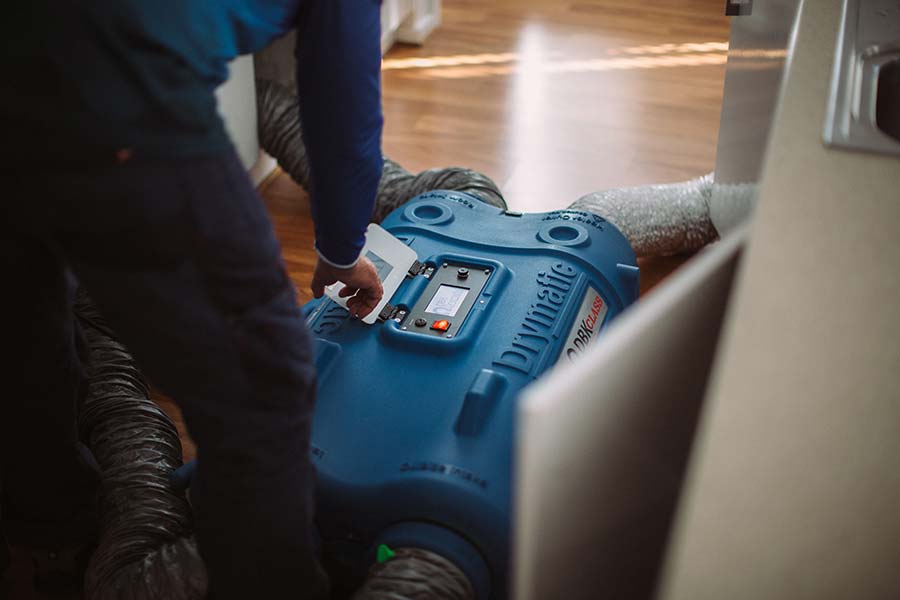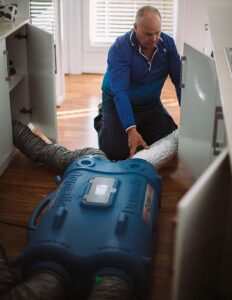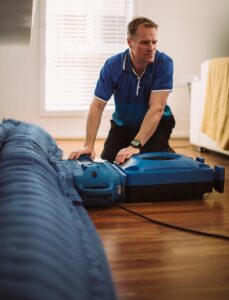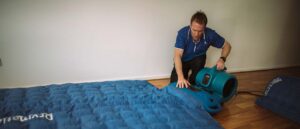What is heat drying & How Does It Dry Water Damage
Heat Drying Technology for Water Damage Restoration
Heat drying is one of the most advanced and effective methods used in modern water damage restoration for drying homes and commercial buildings after flooding or leaks. Unlike traditional drying methods that rely solely on air movement and dehumidification, heat drying uses controlled, high-temperature air to speed up the evaporation process, dramatically reducing drying times and improving overall results.
When this technology first entered the restoration industry, many companies were hesitant to adopt it. Conventional methods were deeply ingrained, and heat drying was initially seen as an unproven concept. However, as restoration professionals began seeing faster drying times, improved moisture removal, and reduced secondary damage, the system quickly gained popularity.
How Heat Drying Water Damage Works
Heat drying systems work by introducing carefully regulated heat into water-damaged areas. The elevated temperatures increase the rate of evaporation from wet materials like carpets, underlay, timber flooring, and structural components such as wall cavities and sub-floors.
The system is designed to work in conjunction with advanced monitoring tools, ensuring that the correct balance of heat, airflow, and humidity is maintained throughout the process. This prevents issues like overheating or warping of building materials while still achieving deep, effective drying.
How Heat Drying Dries Out Water Damaged Properties
The principle behind heat drying for water damage restoration is straightforward yet highly effective. By introducing controlled heat to water-affected materials, the temperature of these surfaces rises, dramatically increasing the rate of evaporation. The more heat applied, the faster the trapped moisture turns into vapour and can be removed from carpets, underlay, walls, timber floors, and other structural elements.
This rapid evaporation significantly reduces overall drying times compared to traditional methods, minimising secondary damage such as mould growth, wood warping, or lingering odours.
The Technology Behind Structural Heat Drying Systems
While the basic science is simple, modern heat drying systems incorporate a wide range of specialised equipment to deliver precise and targeted drying results. These systems often include:
-
Heat mats in various sizes to focus on specific water-damaged areas
-
High-performance heaters designed for safe, efficient drying
-
Heat tubes and fittings to access tight spaces like wall cavities or subfloors
-
Air movers and heat fans to circulate warm air evenly throughout the affected area
-
Moisture monitoring tools to track progress and prevent overheating
This combination allows restoration professionals to tailor the drying approach to each property, ensuring that even hard-to-reach areas are thoroughly dried without causing further damage.
Why Heat Drying Outperforms Conventional Methods
Heat drying doesn’t replace traditional drying techniques like dehumidification and air circulation; rather, it enhances and accelerates the entire restoration process. By integrating heat drying with conventional methods, restoration specialists can:
-
Achieve faster structural drying times
-
Prevent long-term water damage issues such as mould or rot
-
Minimise property disruption and repair costs
-
Access areas that standard drying methods can’t reach effectively
This versatility has made heat drying a game changer in the water damage restoration industry, allowing professionals to deliver more reliable, efficient, and comprehensive drying solutions.
Heat Drying for Structural Water Damage Restoration on the Gold Coast
In cases of severe flooding, where homes or commercial buildings on the Gold Coast have been extensively impacted by water, the damage often goes far beyond carpets and furnishings. In many situations, plasterboard walls, insulation, and floor coverings must be removed due to saturation, mould growth, and the overall severity of the flood damage.
Once all damaged materials have been stripped away, what remains is the building’s structural framework—timber framing, concrete slabs, subfloors, and wall cavities. This stage of the restoration process is known as structural drying or structural remediation, and it plays a critical role in ensuring the property can be safely rebuilt and restored.
Why Heat Drying Excels in Structural Drying
Traditional drying methods like standard air movers and dehumidifiers often struggle to remove deeply trapped moisture from structural materials. Concrete, timber, and brick can hold what’s known as bound moisture, water that becomes locked inside the material and is extremely difficult to evaporate using conventional methods alone.
This is where heat drying technology transforms the restoration process. By safely heating the affected materials to optimal temperatures, the system accelerates the release of moisture deep within walls, floors, and subfloors. Once released, this moisture can be extracted efficiently, drastically reducing drying times and minimising the risk of ongoing water damage or structural weakening.
Benefits of Heat Drying for Structural Water Damage
-
Rapid moisture evaporation – Heat penetrates materials quickly, speeding up the drying process.
-
Access to hard-to-reach areas – Heat drying equipment can target cavities and layers that conventional methods can’t reach effectively.
-
Cost-effective solution – Faster drying times mean reduced restoration costs and less disruption to property owners.
-
Minimises long-term damage – Thorough structural drying helps prevent mould growth, wood rot, and structural instability.
-
Ideal for severe flood damage – Especially valuable when properties have experienced extensive water intrusion.
Why Gold Coast Property Owners Trust Heat Drying
With the region’s tropical climate and the risk of storms and flooding, structural drying on the Gold Coast needs to be fast, effective, and reliable. Heat drying systems deliver unmatched results, making them the preferred choice for professional flood restoration companies aiming to return properties to a safe, dry, and habitable condition as quickly as possible.
Heat Drying for Water-Damaged Timber Floors on the Gold Coast
When timber floors become water-damaged from flooding, leaks, or burst pipes, acting quickly is essential to prevent permanent damage like cupping, warping, or mould growth. One of the most effective solutions now used across the Gold Coast is heat drying technology.
Heat drying has become the preferred timber floor drying method for professional water damage restoration companies and timber floor specialists. Unlike older systems that were often slow and less precise, heat drying delivers faster, more consistent results, helping property owners save expensive flooring that might otherwise need replacing.
How Heat Drying Works on Timber Floors
Heat drying uses specialised heat mats that are placed directly over the affected timber flooring. These mats gently but effectively raise the temperature of the wood, accelerating the natural evaporation process so that moisture locked deep within the boards and sub-floor can escape.
The system is carefully monitored throughout the drying process using moisture detection tools to ensure the right balance of heat and airflow is maintained. While timber floors can take time to dry fully, the method is highly effective and well worth the effort to preserve high-value flooring materials.
Benefits of Heat Drying Timber Floors
-
Faster drying times compared to conventional methods
-
Reduced risk of cupping and warping in hardwood floors
-
Minimal disruption to the property during restoration
-
Targeted drying for affected areas without over-heating surrounding materials
-
Cost-effective restoration compared to full floor replacement
Why Homeowners Choose Us For Water Damage Heat Drying On Th Gold Coast.
At Flood Fixers, we were among the first water damage restoration companies on the Gold Coast to adopt heat drying technology nearly a decade ago. Since then, we have successfully used it on hundreds of water-damaged timber floors and structural drying projects, consistently delivering outstanding results for our customers.
Our team specialises in:
-
Structural drying for flood-damaged properties
-
Timber floor drying and restoration
-
Wet carpet drying and water extraction services
Available across the Gold Coast, we provide 24/7 emergency water damage restoration and are always happy to offer obligation-free advice to help property owners make the best decisions for their homes.
Rapid response emergency water damage service to all Gold Coast Suburbs
With dedicated, professional water damage restoration technicians strategically based throughout the Gold Coast we can get to you fast if you need urgent water extraction, heat drying , mould remediation or any of the professional water damage restoration services that we provide on the Gold Coast.
Southport, Surfers Paradise, Broadbeach, Burleigh Heads, Palm Beach, Coolangatta, Currumbin, Miami, Robina, Varsity Lakes, Mermaid Beach, Mermaid Waters, Nerang, Ashmore, Helensvale, Labrador, Runaway Bay, Hope Island, Biggera Waters, Molendinar, Parkwood, Arundel, Upper Coomera, Coomera, Oxenford, Pacific Pines, Benowa, Carrara, Clear Island Waters, Reedy Creek, Mudgeeraba, Tallebudgera, Elanora, Tugun, Hollywell





